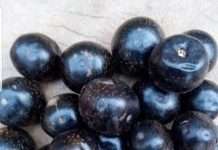
Celery (Apium graveolens L.) is an annual or perennial plant that is widespread in distribution and belongs to the Parsley family, Apiaceae. It is called seleri ganye in Hausa, celeri in Igbo and seleri in Yoruba.
Constituents
Celery contains the flavonoids apigenin, luteolin and quercetin; steroid compounds like androstenone, androstenol and phytoestrogens.
Other compounds like butylphthalides, sedanolide, apiuman and fatty acids are present, as well as water, energy, protein, fibre, carbohydrate and sugars. Celery contains antioxidants, vitamins A,C,K and folate, as well as the minerals – calcium, potassium, magnesium, iron, sodium and manganese.
Preparations
Celery is available as the raw stalk or leaves, juice, oil or capsule of the oil. It is used as an ingredient in stocks, sauces, soups, salads, wines and smoothies. It can be chopped, boiled, steamed, baked or stir-fried.
Pharmacological actions and medicinal uses
The anti-inflammatory properties of celery, derived from apigenin and luteolin, contribute to its pharmacological actions in cancer, asthma, ulcer, arthritis, among other inflammatory diseases.
Studies have reported that its potentials in the treatment of pancreatic and breast cancers lie in its chemo-preventive, anti-carcinogenic and autophagic properties, as well as its ability to inhibit cell proliferation.
Studies reveal that nitrates and a phytochemical, called phthalides – which relaxes the artery walls, increase blood flow and expand the smooth muscles – are responsible for the antihypertensive properties of celery. Also, the celery leaf extract can improve numerous cardiovascular parameters like cholesterol, triglycerides, and LDL (bad cholesterol). It may lower the rates of age-related memory loss through the treatment of neuroinflammatory disorders; thus, it may help reduce the risk of neurodegeneration.
Anecdotal evidence suggests that celery may promote digestive health, as a result of the presence of both soluble and insoluble fibre that promotes bowel movement. The insoluble fibre content of celery can increase satiety and, together with high water content, aid weight loss. Studies also suggest that taking celery may lower the risk of type 2 diabetes.
The androstenone and androstenol in celery are male hormones that are believed to increase libido in men and women; and, in men, may increase the secretion of testosterone and sperm count. Celery may be used to reduce the flow of breast milk and in treating menstrual and menopausal discomfort.
There is limited research to show that celery seeds possess antifungal and antibacterial properties that could be useful in the treatment of asthma. Celery may be useful in the treatment of kidney stones, due to the fact that apigenin, found in celery, can break down calcium crystals found in kidney stones.
Studies show that the anti-arthritic and diuretic (promoting the excretion of uric acid) properties, as well as the presence of sedanolide in celery seed extracts, make it useful in the treatment of joint pains, rheumatism and gout.
The furanocoumarins found in celery may help in the treatment of vitiligo, through hydration of the skin.
Adverse effects
Celery may cause severe anaphylactic shock. Symptoms can include swelling of the face, irritation, rashes, upset stomach, and dizziness. In extreme cases, the symptoms can include a drop in blood pressure and difficulty breathing. Celery or celery seeds may induce bleeding and uterine contractions. Hence, pregnant women must avoid eating too much celery.
Economic uses and potentials:
In 2023, the approximate price range for US celery is between US$ 1.25 and US$ 0.74 per kilogram. Celery sells at between N960 to N4,800 per wrap in Nigeria. The potentials of celery in the pharmaceutical, food and cosmetic industries are enormous. This calls for more research and development on this cool plant, called celery.
References
Koganti S (2023). 15 Celery Benefits, How To Consume It, And Side Effects. Stylecraze. Jan 31.













